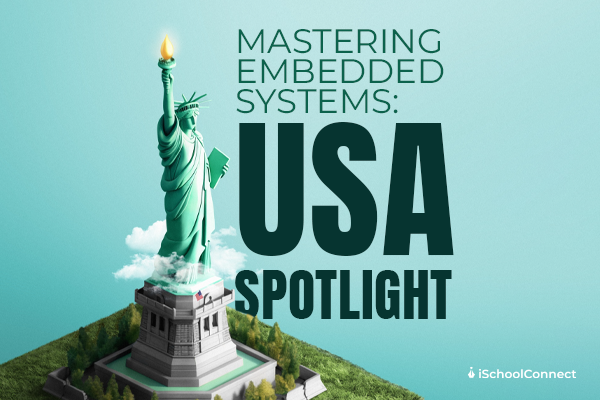Table of Contents
Understanding MS in Embedded Systems
Embedded systems play a pivotal role in shaping the future. From smartphones to medical devices and even household appliances, embedded systems are the silent heroes behind the scenes. These systems require a unique blend of hardware and software expertise, making them a fascinating field of study. If you’re considering pursuing a Master of Science (MS) in Embedded Systems, the USA offers a plethora of opportunities to dive into this exciting field. In this comprehensive guide, we will explore the nuances of an MS in Embedded Systems in the USA, from program details to career prospects and everything in between.
Defining MS in Embedded Systems
Before discussing the specifics, let’s define what an MS in Embedded Systems entails. It is a specialized postgraduate program that equips students with the knowledge and skills required to design, develop, and optimize embedded systems. These systems typically consist of hardware and software components intricately interwoven to perform specific tasks efficiently. An MS program in this field delves deep into the technical aspects, providing students with a holistic understanding of it.
Key components of MS Program
Following are the key components of MS Program
Core curriculum
A typical MS program in Embedded Systems includes a core curriculum that covers fundamental concepts and essential skills. This core curriculum often includes courses in areas such as real-time operating systems, microcontroller programming, and digital signal processing. These courses lay the foundation for a deep understanding of it and it’s applications.
Elective courses
To cater to the diverse interests of students, MS programs usually offer a range of elective courses. Some popular specializations include the Internet of Things (IoT), robotics, automotive embedded systems, and medical devices. Elective courses enable students to tailor their education to align with their career goals.
Research opportunities
Research is a crucial aspect of any MS program, and embedded systems are no exception. Students often have the opportunity to engage in research projects that address real-world challenges in the field. These projects not only enhance knowledge but also provide valuable hands-on experience.
Admission requirements
Admission to this program in the USA is competitive, and applicants must meet specific prerequisites and fulfill admission requirements. These may include-
- A bachelor’s degree in a relevant field (e.g., electrical engineering, computer science, or computer engineering).
- Competitive GRE (Graduate Record Examination) scores.
- Proficiency in English, demonstrated through TOEFL or IELTS scores (for international students).
- Letters of recommendation.
- A well-crafted statement of purpose outlining the applicant’s academic and career goals.
- Relevant coursework or experience in programming, microcontrollers, and digital systems.
Meeting these requirements demonstrates a candidate’s readiness for the program and their commitment to pursuing a career in it.
Read more: Master of Science in USA: Top Universities, Courses, Cost, Eligibility
The USA as a hub for Embedded Systems Education

- Overview of the USA’s Higher Education System – The United States boasts a robust higher education system known for its academic excellence and innovation. American universities are at the forefront of technological advancements, making them ideal destinations for students .
- Prominent Universities Offering MS in Embedded Systems – Several prestigious universities across the USA offer top-notch MS programs. Here are some of the institutions that standout
- Stanford University – Stanford University is renowned for its cutting-edge research and innovation. Its MS program in Electrical Engineering, is highly regarded in the field.
- Massachusetts Institute of Technology (MIT) – MIT, a leader in technology and engineering, offers an MS in Electrical Engineering and Computer Science with a concentration in embedded systems.
- University of California, Berkeley – UC Berkeley‘s Electrical Engineering and Computer Sciences department offers MS program enabling students to work on groundbreaking research.
- Carnegie Mellon University – Carnegie Mellon‘s School of Electrical and Computer Engineering offers an MS in Electrical and Computer Engineering with a concentration in embedded software engineering.
- University of Texas at Austin – The University of Texas at Austin offers an MS program in Electrical and Computer Engineering, allowing students to specialize in embedded systems.
Rankings and recognition
These universities consistently rank among the top institutions globally for engineering and technology programs. Their renowned faculty and cutting-edge research facilities make them attractive choices.
Scholarships and financial aid
Many universities in the USA offer scholarships, grants, and fellowships to help offset the cost of education. These financial aid opportunities can make pursuing this program more affordable and accessible for students.
Curriculum and Specializations

Curriculum and courses are devided into two parts one as common core courses and another one is specialization track.
Common core courses
The core curriculum of this program typically includes a set of foundational courses that all students are required to take. These courses include-
- Embedded Systems Design – This course focuses on the principles and methodologies of designing embedded systems, emphasizing the integration of hardware and software components.
- Real-Time Operating Systems – Students learn about real-time operating systems and how they manage tasks, scheduling, and resource allocation in embedded systems.
- Microcontroller Programming – This course covers programming microcontrollers, a key component of embedded systems, and teaches students how to interface with sensors and actuators.
- Digital Signal Processing – Digital signal processing is a fundamental skill in embedded systems. This course explores techniques for processing and manipulating digital signals.
Specialization tracks
To cater to the diverse interests and career goals of students, MS programs in Embedded Systems often offer specialization tracks. These tracks allow students to focus on specific areas such as
- Internet of Things (IoT) -Students specializing in IoT learn how to create interconnected devices and systems, enabling them to contribute to the expanding IoT landscape.
- Robotics – The robotics track focuses on designing and programming robots for various applications, including industrial automation, healthcare, and autonomous vehicles.
- Automotive Embedded Systems – In this specialization, students delve into the intricacies of embedded systems used in the automotive industry, including safety-critical systems.
- Medical Devices -This track equips students with the knowledge and skills needed to work on embedded systems used in medical devices, such as pacemakers, infusion pumps, and diagnostic equipment.
Capstone projects and thesis requirements
To culminate their MS journey, students often undertake capstone projects or thesis research. These projects allow students to apply their knowledge to real-world problems and demonstrate their expertise to potential employers. Thesis research, on the other hand, involves in-depth exploration of a specific research topic under the guidance of faculty advisors.
Alumni success stories
- Profiles of notable alumni – To provide a glimpse of the potential outcomes of pursuing this program in the USA, let’s explore some notable alumni who have made significant contributions to the field-
- John Doe – Inventor of a breakthrough IoT device – John Doe, an alumnus of Stanford University’s Embedded Systems program, went on to invent a groundbreaking IoT device that revolutionized home automation. His invention led to a successful startup and garnered international recognition.
- Jane Smith – Pioneer in Medical Device Embedded Systems -Jane Smith, a graduate of MIT’s program, is a pioneer in the development of embedded systems for medical devices. Her work has improved patient care and safety, and she holds multiple patents in the field.
- Their contributions to the field – Their contributions to technology and innovation have not only advanced the field but have also inspired future generations.
- How the MS Program shaped their careers– In interviews, these alumni often attribute their success to the strong foundation and opportunities provided by their MS programs. The rigorous coursework, research experiences, and access to leading faculty members were instrumental in shaping their careers.
Key takeaways
- Pursuing MS in in this field in the USA opens doors to a world of innovation and technology. From renowned universities and faculty to cutting-edge research and industry collaborations, the USA offers an ideal environment for aspiring engineers.
- The combination of a strong academic foundation, specialization options, and real-world experience positions graduates for successful and impactful careers in this dynamic field.
- So, if you’re ready to dive into the exciting world of embedded systems, consider the USA as your educational destination and embark on a journey of knowledge, innovation, and discovery.
We hope you found this blog informative! If you have any questions or would want more information about international study programs, please don’t hesitate to reach out. Contact us today, and our knowledgeable team will be delighted to assist you.
Liked this blog? Read next: Data science | Top Universities & courses for Master’s in the UK
FAQs
Q1. Can I pursue an MS in Embedded Systems in the USA without a background in engineering or computer science?
Ans: While many programs prefer applicants with a background in engineering, computer science, or related fields, some universities may consider applicants from diverse academic backgrounds. However, it’s essential to demonstrate a strong aptitude for technical subjects and programming through relevant coursework or experience. Before starting the program, you may need to complete prerequisite courses to bridge any knowledge gaps.
Q2. Are there opportunities for international students to work in the USA after completing an MS in Embedded Systems?
Ans: Yes, international students in the USA on an F-1 visa are typically eligible for Optional Practical Training (OPT) after completing their MS program. OPT allows you to work in your field of study for up to 12 months, with an additional 24-month extension available for STEM (science, technology, engineering, and mathematics) graduates.
Q3. What are the emerging areas of research within the field of Embedded Systems that students should be aware of?
Ans: The field of Embedded Systems is continually evolving, and several emerging areas of research are worth exploring. These include Edge Computing, Cybersecurity, Artificial Intelligence (AI) Integration, and Quantum Embedded Systems.






